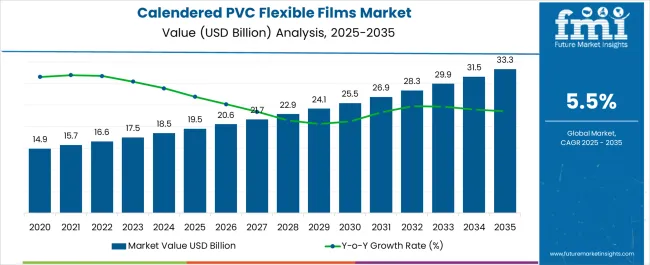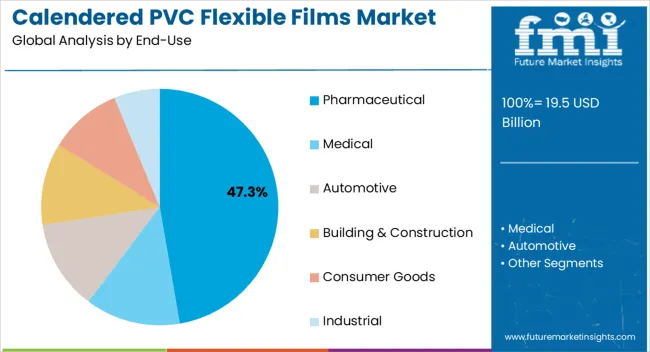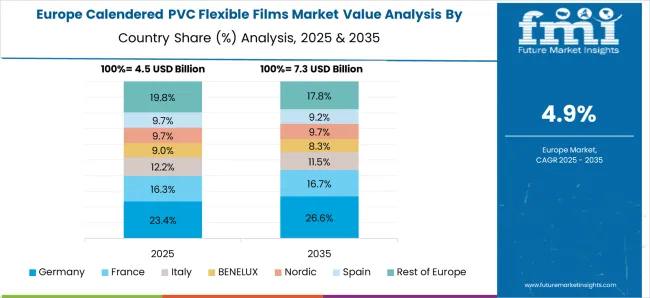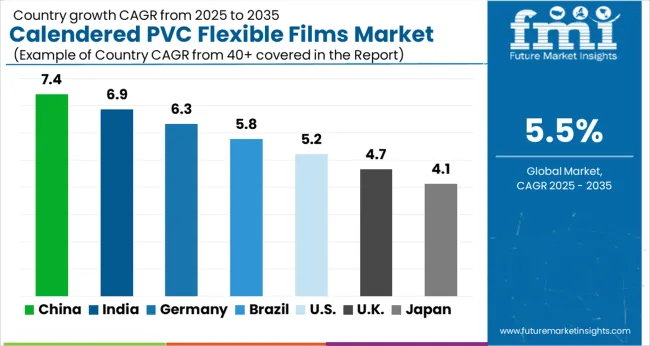The Calendered Polyvinyl Chloride Flexible Films Market is estimated to be valued at USD 19.5 billion in 2025 and is projected to reach USD 33.3 billion by 2035, registering a compound annual growth rate (CAGR) of 5.5% over the forecast period.

| Metric | Value |
|---|---|
| Calendered Polyvinyl Chloride Flexible Films Market Estimated Value in (2025 E) | USD 19.5 billion |
| Calendered Polyvinyl Chloride Flexible Films Market Forecast Value in (2035 F) | USD 33.3 billion |
| Forecast CAGR (2025 to 2035) | 5.5% |
The calendered polyvinyl chloride flexible films market is expanding steadily due to their versatility, durability, and wide adoption across multiple industries. Rising demand in pharmaceutical packaging has been a significant driver, given the material’s ability to provide superior moisture resistance, clarity, and chemical stability.
Increasing regulatory focus on safe and reliable packaging for medicines and medical devices has accelerated usage in blister packs and other pharmaceutical applications. Technological advancements in film processing and improved recycling techniques are also supporting growth by enhancing performance and sustainability.
Furthermore, the expanding healthcare sector in emerging economies and the growing global need for cost effective yet reliable packaging are expected to sustain market momentum. The outlook remains positive as industries continue to emphasize quality, compliance, and efficiency in flexible packaging materials.

The pharmaceutical segment is projected to hold 47.30% of total revenue by 2025 under the end use category, making it the dominant segment. This position is driven by the widespread use of calendered PVC flexible films in pharmaceutical blister packs and medical device packaging.
The material’s superior barrier properties, chemical resistance, and transparency ensure product safety and shelf life, which are critical in the healthcare sector. Growing demand for unit dose packaging and compliance packaging for patients has further increased adoption.
Additionally, regulatory requirements for tamper evident and protective packaging have reinforced the use of PVC films. With rising global healthcare expenditure and an expanding pharmaceutical supply chain, the pharmaceutical segment continues to lead, supported by its consistent demand for safe, reliable, and cost effective packaging solutions.
Increased usage in construction activities
The calendered polyvinyl chloride flexible films are one of the most widely used products for building and construction. Owing to their quality and safety, the sales of calendered polyvinyl chloride flexible films are expected to surge during the forecast period.
Fire resistant
Safety becomes a very important parameter when dealing with products in large numbers. The calendered polyvinyl chloride flexible films offer high safety. The presence of chlorine ensures that the product does not ignite easily.
Cost-effective
Apart from the number of advantages offered by calendered polyvinyl chloride flexible films, these are cost-effective as well. The ability to be manipulated into desired shape and size is expected to increase the demand for calendered polyvinyl chloride flexible films.
Current resistant
One of the most important benefits of calendered polyvinyl chloride flexible films is that these do not conduct electricity. This allows manufacturers to provide a packing that is both fire and current-resistant
Tamper-resistant seals
The calendered polyvinyl chloride flexible films are used in large numbers for the manufacture of tamper-resistant seals. The usage of these seals displays the genuity of the product.
Eco friendly
The application of calendered polyvinyl chloride flexible films ensures that the product has no side effects on the environment, as tested by FDA, CPSC, and ISS. These factors might surge the sales of calendered polyvinyl chloride flexible films in the forecast period.
Rising demand in food packaging
These films are majorly used for packaging meat and many other kinds of fresh perishable food items.
One of the major restraints of making use of calendered polyvinyl chloride flexible films is that if by any chance the packaging catches fire, it would emit gases that are harmful to our respiratory system. So, the demand for calendered polyvinyl chloride flexible films could be potentially impacted.
Ban on plastic packaging
There are many countries that have banned the usage of plastics. This presents a sea of opportunity for these films, as these are potentially used as an alternative to plastics.
Importance being realized in healthcare sector
The healthcare sector is advancing at a massive rate worldwide. The importance of employing the calendered polyvinyl chloride flexible films is being gradually realized, as it represents a cost-effective way of maintenance.
All these are expected to surge the sales of calendered polyvinyl chloride flexible films.
Acceptance of Polystyrene as an alternative to plastic bags
Plastic bags are gradually being replaced with other suitable packaging types in many parts of the world. One of the products which is quite often used is polystyrene. This is a potential threat to the calendered polyvinyl chloride flexible films market.
| Attributes | Details |
|---|---|
| Demand |
|
| Restraints |
|
| Opportunities |
|
| Threats |
|
To make things simpler, the Calendered Polyvinyl Chloride Flexible Films Market is a perfect combination of 4 P’s:
Looking at the prospects of adopting the Calendered Polyvinyl Chloride Flexible Films, the promoters are taking all efforts from their side to increase the sales of such packaging. The promotion activity is carried out mainly via offline mode through collaborations, trade shows, etc. This is well expected to increase the demand for calendered polyvinyl chloride flexible films.
Existing Trends in the Calendered Polyvinyl Chloride Flexible Films Market
Currently, there is a rising influx of rural populations to urban areas. These are the people, who in the initial days have to face a shortage of food because of the lack of resources. To save money, they consume street food or readily available food.
The calendered polyvinyl chloride flexible films are used for packaging such food items as it increases the shelf life of the food and covers the odor of the packed food. The above reason is valid for those people as well who are leading a hectic lifestyle, because of lack of time to prepare food on their own.
The consumer goods segment currently has the highest market share in the calendered polyvinyl chloride flexible films market. As of 2025, the market share of the consumer segments is slightly greater than 25%, and during the forecast period, the demand for calendered polyvinyl chloride flexible films is expected to surge.
There is rising usage of these films in the pharmaceutical sector for packing various kinds of medical equipment. The calendered polyvinyl chloride flexible films have high relevance in the automotive sector as well. These are used on the body of the car to avoid wear and tear.
This is done to further see that the painting is not damaged in any way. If we talk about one segment in which its usage is exponentially increasing, it is the building and construction segment for the purpose of wallcovering, flooring, etc.
Any product that is used in industries should be durable, operationally and environmentally safe, cost-effective, multi-purposeful, etc. All these qualities are possessed by the calendered polyvinyl chloride flexible films. This is further expected to increase the sales of calendered polyvinyl chloride flexible films.
The calendered polyvinyl chloride flexible films are used in a number of other applications like waterproof enclosures, windows, and siding, furniture and supply covers, wire harnesses, etc.
Asia Pacific is currently the largest market for calendered polyvinyl chloride flexible films, having a share of nearly 28%. Rapid development, coupled with increasing urbanization, and more and more people leading a hectic lifestyle are some of the reasons why the market is currently dominating and is expected to grow during the forecast period as well.
The product being cost-effective will most likely drive the sales of calendered polyvinyl chloride flexible films during the forecast period.
The calendered polyvinyl chloride flexible films market is expected to expand in North America during the forecast period. The reason is the increased usage of these films in the medical and healthcare sector. These are used for packaging certain healthcare equipment. These films are used in the pharmaceutical sector as well for blister packaging.
There are a number of industries that operate in this region. Owing to plenty of benefits offered by these films, these are being adopted in industries as well. All these are expected to increase the calendered polyvinyl chloride flexible films market share in North America. North America held a market share of 30.4% in 2025.

The calendered polyvinyl chloride flexible films market is anticipated to surge in Europe during the forecast period. Apart from the rising usage in all the sectors, there are plenty of funds available with the manufacturers in this region, because of which they can afford to promote the product.
The eco-friendly aspect of these films coupled with the capability to be fire resistant is expected to drive the demand for calendered polyvinyl chloride flexible films in Europe. Europe held a market share of 24.4% in 2025.
Based on the analysis conducted by Future Market Insights, it was found that as per the analysis done on countries, China is the biggest market for calendered polyvinyl chloride flexible films. The reasons are listed below:
The start-up space of calendered polyvinyl chloride flexible films market is on a rollout for providing high-efficiency and low-cost packaging. Some of the startups are: vertrauen chemie solutions, Indevco Plastics, and Bizongo.
| Start-up name | Vertrauen Chemie Solutions |
|---|---|
| Start-up year | 2020 |
| Description | Develops packaging for liquids which are difficult to handle. Offers solutions to aerospace, automotive, construction, marine, and oil and gas. |
| Start-up name | Indevco Plastics |
|---|---|
| Start-up year | 2020 |
| Description | Uses post-consumer, post-industrial, and virgin resins for polyethylene centerfold sheeting. |
| Start-up name | Bizongo |
|---|---|
| Start-up year | 2020 |
| Description | Develops packaging for food and beverage businesses, which protects products across life cycle. |
Some of the other start-ups are Plexform and Interface polymers, and these primarily deal with industrial bulk packaging and packaging based on polyolefin.

With a view to expand footprints, and to serve many other sectors, the key players are currently involved in mergers and acquisitions. The expansion of portfolio would ensure that the specialty compounds are included as well, apart from the existing PVC materials.
| Company | Teknor Apex |
|---|---|
| Month and Year | June 2025 |
| News | Teknor Apex announced NEW Sarlink R2 3180 B TPV with 25% recycled content. This multipurpose TPV contains high quality Post-Industrial Recycled content processes. |
| Company | Hexis SAS |
|---|---|
| Month and Year | June 2025 |
| News | Hexis visted La Fabrique in Paris, which is a French school for decoration and fashion industry. The students created a window display with Hexis products, in line with the 2025 decoration trend |
| Company | Renolit SE |
|---|---|
| Month and Year | May 2025 |
| News | Renolit SE and Sobernheimer Rohstoff Kontor Gmbh have founded a joint venture, KAS Kunststoff Aufbereitung Bad Sobernheim GmbH to jointly distribute PVC recyclates derived from production residues. |
| Company | Lawson Screen and Digital Products |
|---|---|
| Month and Year | September 2025 |
| News | FDC series 4200 Intermediate Ultra High Gloss Vinyl Film, introduced by Lawson Screen and Digital Products, is an ultra high gloss calendered vinyl film. This item is ideal for exterior and interior uses that require a high grade markings film for adaptability, resilience, and sunlight protection. |
| Company | Ronal DGA |
|---|---|
| Month and Year | August 2025 |
| News | Gloss Calendered Vinyl PRO (ESM-GCPRO), introduced by Ronal DGA, is the most recent innovation to their calendered vinyl portfolio. This high-end item is a glossy 3 mm calendered vinyl with grey detachable adhesive and an air-release lining. |
| Report Attribute | Details |
|---|---|
| Growth Rate | CAGR of 5.5% from 2025 to 2035 |
| Base Year for Estimation | 2025 |
| Historical Data | 2020 to 2025 |
| Forecast Period | 2025 to 2035 |
| Quantitative Units | Revenue in USD million and CAGR from 2025 to 2035 |
| Report Coverage | Revenue Forecast, Volume Forecast, Company Ranking, Competitive Landscape, Growth Factors, Trends, and Pricing Analysis |
| Segments Covered | End Use, Region |
| Regions Covered | North America; Latin America; Europe; Asia Pacific; Middle East & Africa |
| Key Countries Profiled | United States, Canada, Brazil, Mexico, Germany, United Kingdom, France, Spain, Italy, Russia, India, Australia, China, Japan, South Korea, Saudi Arabia, UAE, South Africa, Israel |
| Key Companies Profiled | Mississippi Polymers, Inc.; Teknor Apex Company, Inc.; Canadian Speciality Vinyls; South Asia Plastics Group; ACG; Caprihans India Limited; Mondorevive S.p.a.; ALFATHERM SpA; HEXIS S.A.S.; ZHONGSHAN LIN-YANG PLASTIC CO.LTD.; Merck KGaA |
| Customization & Pricing | Available Upon Request |
The global calendered polyvinyl chloride flexible films market is estimated to be valued at USD 19.5 billion in 2025.
The market size for the calendered polyvinyl chloride flexible films market is projected to reach USD 33.3 billion by 2035.
The calendered polyvinyl chloride flexible films market is expected to grow at a 5.5% CAGR between 2025 and 2035.
The key product types in calendered polyvinyl chloride flexible films market are pharmaceutical, medical, automotive, building & construction, consumer goods and industrial.
In terms of , segment to command 0.0% share in the calendered polyvinyl chloride flexible films market in 2025.






Full Research Suite comprises of:
Market outlook & trends analysis
Interviews & case studies
Strategic recommendations
Vendor profiles & capabilities analysis
5-year forecasts
8 regions and 60+ country-level data splits
Market segment data splits
12 months of continuous data updates
DELIVERED AS:
PDF EXCEL ONLINE
Super Calendered Glassine Paper Market Size and Share Forecast Outlook 2025 to 2035
Polyvinyl Butyral PVB Market Size and Share Forecast Outlook 2025 to 2035
Polyvinylidene Fluoride (PVDF) Market Growth - Trends & Forecast 2025 to 2035
Polyvinyl Butyral Market Growth – Trends & Forecast 2024-2034
Polyvinyl Alcohol (PVA) Films Market Size and Share Forecast Outlook 2025 to 2035
Polyvinyl Chloride (PVC) Packaging Film Market Forecast and Outlook 2025 to 2035
Polyvinyl Chloride Market Growth – Trends & Forecast 2024-2034
Europe Polyvinyl Alcohol Industry Analysis Size and Share Forecast Outlook 2025 to 2035
TPE Films and Sheets Market Size and Share Forecast Outlook 2025 to 2035
Breaking Down PCR Films Market Share & Industry Positioning
PCR Films Market Analysis by PET, PS, PVC Through 2035
LDPE Films Market
Card Films Market
Mulch Films Market Size and Share Forecast Outlook 2025 to 2035
Nylon Films for Liquid Packaging Market from 2024 to 2034
Vinyl Films Market
MDO-PE Films Market Analysis by Cast Films and Blown Films Through 2035
Edible Films and Coatings Market Growth - Trends & Forecast 2025 to 2035
Market Share Breakdown of Edible Films and Coatings
Retort Films Market

Thank you!
You will receive an email from our Business Development Manager. Please be sure to check your SPAM/JUNK folder too.
Chat With
MaRIA